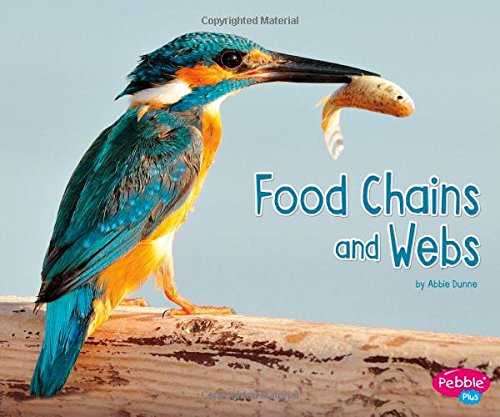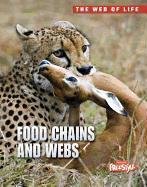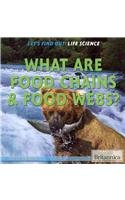-
Who Eats What?: Food Chains and Food Webs
Patricia Lauber, Holly Keller
Paperback (HarperCollins, Feb. 2, 2016)What do you and a tuna have in common? You are both part of a food chain that begins with green things and ends with you! Can you get energy from sunlight? Why is every link in a food chain important? Read and find out more about food chains! This nonfiction picture book is an excellent choice to share during homeschooling, in particular for children ages 4 to 6. It’s a fun way to learn to read and as a supplement for activity books for children.Now rebranded with a new cover look, this book features content-rich vocabulary in simple, engaging text by Patricia Lauber, fascinating diagrams, and beautifully detailed illustrations by Holly Keller. Both text and artwork were vetted for accuracy.This is a Level 2 Let's-Read-and-Find-Out Science title, which means the book explores more challenging concepts for children in the primary grades and supports the Common Core Learning Standards, Next Generation Science Standards, and the Science, Technology, Engineering, and Math (STEM) standards. Let's-Read-and-Find-Out Science is the winner of the American Association for the Advancement of Science/Subaru Science Books & Films Prize for Outstanding Science Series. M
M
-
What Are Food Chains and Webs?
Bobbie Kalman
Paperback (Crabtree Pub Co, March 15, 1998)A simple introduction to food chains and webs, featuring both herbivores and carnivores and discussing energy, food production, and decomposition in various ecosystems Q
Q
-
Food Chains and Webs
Abbie Dunne
Paperback (Capstone Press, Aug. 1, 2016)Simple text and bright photographs explain the concept of food chains and webs for beginning readers. The book concludes with a simple, kid-friendly activity. M
M
-
Food Chains and Webs
Andrew Solway
Paperback (Raintree, Jan. 1, 2012)Food Chains and Webs explains that feeding relationships are at the heart of life on Earth. It looks at the different types of living things in a food web - from producer to top consumer - as well as food pyramids and topics like bioaccumulation. It tackles common confusions about the science and shows how topics are relevant to the reader.
-
Who Eats What? Food Chains and Food Webs
Patricia Lauber, Holly Keller
Paperback (HarperCollins, Dec. 14, 1994)Informative and intriguing, this science book teaches children to think about the complex and interdependent web of life on Earth. Every link in a food chain is important because each living thing depends on others for survival, no matter how big or how small. Lively drawings from Holly Keller illustrate the clear, simple text by Patricia Lauber. This is a Stage 2 Let's-Read-and-Find-Out, which means the book explores more challenging concepts for children in the primary grades. Let's-Read-And-Find-Out is the winner of the American Association for the Advancement of Science/Subaru Science Books & Films Prize for Outstanding Science Series. Supports the Common Core Learning Standards and Next Generation Science Standards M
M
-
Who Eats What?: Food Chains and Food Webs
Patricia Lauber, Holly Keller
Hardcover (Harpercollins Childrens Books, Jan. 1, 1995)Explains the concept of a food chain and how plants, animals, and humans are ecologically linked M
M
-
Food Chains and Webs
Andrew Solway
Paperback (Raintree, Jan. 1, 2012)Food Chains and Webs explains that feeding relationships are at the heart of life on Earth. It looks at the different types of living things in a food web - from producer to top consumer - as well as food pyramids and topics like bioaccumulation. It tackles common confusions about the science and shows how topics are relevant to the reader.
-
What Are Food Chains and Webs?
Bobbie Kalman, Jacqueline Langille
Audio CD (Crabtree Publishing Company, Oct. 1, 2008)Sunlight does not go very deep into water so seaweed must grow at the surface where its rays can reach them. Starting with the sun, food chains link together plants and animals in various ecosystems to help them survive. N
N
-
What Are Food Chains and Food Webs?
Julia Vogel, Hazel Adams, Jacques Finlay
Library Binding (Magic Wagon, Sept. 1, 2010)"Food chains are fascinating! Did you know that all food starts with the sun? Plants use the sun's energy to grow, and then they become energy for animals. Every environment has factors that affect the flow of energy in its food chains--all the way up to you! Discover what plants and animals create the links of food chains and webs in each environment." -- p. 4 of cover. P
P
-
What Are Food Chains & Food Webs?
Louise Spilsbury
Paperback (Britannica Educational Pub, Jan. 1, 2014)This book explains the transfer of energy between living thingsknown as the food chainin a way that allows any reader to grasp the scientific principles behind food chains and food webs. The diets of herbivores, carnivores, and omnivores are explained, as well as other types of diets, and the flow of energy between these groups is made clear with arrowed diagrams and colorful pictures that show where different species derive their energy. Also examined are the effects different habitats have on the food chain, and how food chains in different environmental regions can be contrasted. U
U
-
What Are Food Chains and Webs?
Bobbie Kalman
Audio CD (Crabtree Publishing Company, Oct. 30, 2008)Sunlight does not go very deep into water so seaweed must grow at the surface where its rays can reach them. Starting with the sun, food chains link together plants and animals in various ecosystems to help them survive. N
N
-
What Are Food Chains & Food Webs?
Louise A Spilsbury
Library Binding (Rosen Education Service, Jan. 1, 2014)This book explains the transfer of energy between living thingsknown as the food chainin a way that allows any reader to grasp the scientific principles behind food chains and food webs. The diets of herbivores, carnivores, and omnivores are explained, as well as other types of diets, and the flow of energy between these groups is made clear with arrowed diagrams and colorful pictures that show where different species derive their energy. Also examined are the effects different habitats have on the food chain, and how food chains in different environmental regions can be contrasted. U
U